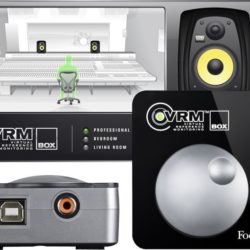Mix in different environments through different speakers and from different positions just with headphones.
Focusrite’s VRM overcomes the major obstacle for mixing with headphones by giving you multiple perspectives on your mix, as if you were listening through speakers. Indeed, noise levels from mixing through speakers can make it impossible for most to mix at home, especially late at night; with VRM, you can mix any time, anywhere. Using any pair of monitoring headphones, VRM lets you choose your mixing environment from a living room, a bedroom studio, or a professional studio. You then simply choose from a list of industry-standard studio monitors and speakers
VRM Box delivers audio quality worthy of your headphones. Boasting a dynamic range of 108dB, it provides a sound that’s more precise with lower distortion than other low-cost audio interfaces, and far superior to built-in laptop headphone outputs.
VRM Box functions as a high-quality 24-bit/48kHz USB audio playback interface. So, whether you’re mixing, creating music or simply listening to tracks, VRM Box is perfect. What’s more, there’s no need for a power supply or batteries, because it gets all the power it needs from your computer’s USB port with full audio quality. VRM Box also features a digital S/PDIF input, which supports sample rates up to 192kHz. This allows you to run it in conjunction with your Pro Tools HD system or any other interface with an S/PDIF output.
Pocket sized and built to last, VRM Box places Focusrite’s proven and patent-pending VRM—Virtual Reference Monitoring—technology in a robust, palm-sized audio interface.
Virtual Reference Monitoring
The Problem
VRM (Virtual Reference Monitoring) is Focusrite’s own loudspeaker and room simulator designed for headphone listening. Until now, accurate mixing has required expensive monitors and a carefully designed and treated control room. Currently, both professional music producers facing budgetary limitations, and project music makers without access acoustically treated control rooms frequently encounter mixing and auditioning difficulties.
The Solution
VRM allows you to choose from 10 pairs of industry standard nearfield and main monitors in an acoustically treated control room.
Engineers routinely A/B their mixes by burning CDs and taking them into untreated rooms to reference on consumer stereos. VRM eliminates this process by simulating two extra rooms: a large living room and a smaller bedroom. You can choose between a range of speakers including quality hi-fi, computer, cheap stereo, and television speakers.
The Method
VRM Box uses standard headphones to reproduce the direct sound along with software running on your computer that is used to simulate specific monitoring scenarios. VRM’s room models are mathematical models that provide greater flexibility in the possible combinations of loudspeakers. The loudspeaker simulations are created using convolutions of impulse responses measured using the original loudspeakers. The accuracy of these simulations in different environments is taken care of by the impulse responses themselves and the way they are calculated and manipulated.






Join the discussion
comments powered by Disqus